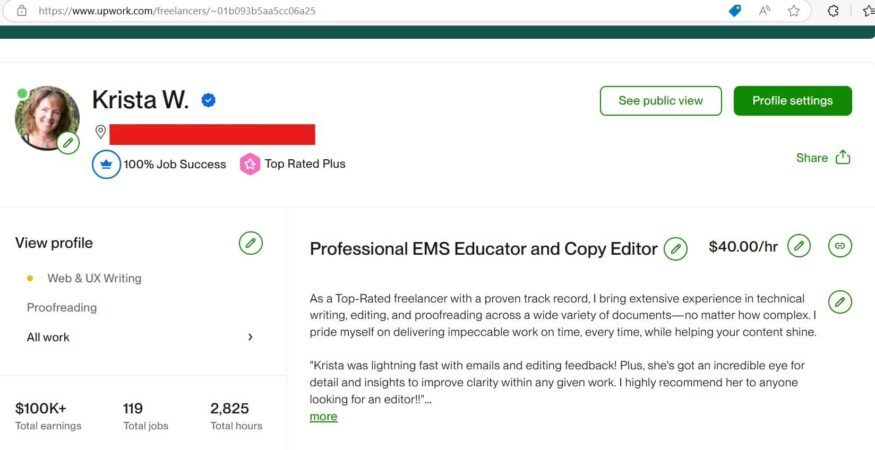Upwork has been a game-changer for millions of freelancers worldwide, including myself. When I first joined the platform six years ago, I landed my first job for just $5. It felt like a small win then, but it was the start of an incredible journey. Today, I earn over $40 per hour and have made over $100,000, working mostly part-time from home.
However, as of 2025, Upwork faces its fair share of challenges. From rising fees to concerns about its longevity as a platform, freelancers ask: Is Upwork still worth it?
For anyone looking to start or grow their freelancing career, Upwork still offers endless opportunities—but it’s not without its challenges. In this honest guide, I’ll share everything I’ve learned about the platform: how it works, its pros and cons, and strategies for success.
This post may contain affiliate links. If you click on them, I may earn a small commission at no additional cost to you. Thank you for your support!
What Is Upwork and How Does It Work?
 Upwork is a freelancing platform that allows clients to post projects and freelancers to bid on them. The platform covers a wide range of job categories, including:
Upwork is a freelancing platform that allows clients to post projects and freelancers to bid on them. The platform covers a wide range of job categories, including:
- Writing & Editing
- Legal
- Engineering & Architecture
- Graphic Design
- Web, Mobile, & Software Development
- Sales & Marketing
- Customer Service
- IT & Networking
Key Features of Upwork
Upwork offers a dynamic platform that connects freelancers with clients worldwide, providing tools and systems designed to simplify project management and ensure secure, efficient collaborations. Here are a few key features:
- Job Posting and Bidding System: Clients post projects, and freelancers submit proposals using paid Connects (tokens) to win jobs.
- Payment Protection: Upwork uses escrow to ensure freelancers get paid for completed work.
- Communication Tools: Chat and email features, file sharing, and time-tracking tools for seamless collaboration.
Recent Trends and Data About Upwork

When researching a freelance platform, some questions you might have include the following:
- Freelancing Growth: By 2025, over 40% of the global workforce is expected to engage in freelancing or gig work.
- Popular Job Categories: Writing, design, and programming remain in demand, but new trends include roles in AI, data analysis, and social media management.
- Remote Work Expansion: With more companies adopting remote work, Upwork continues to attract both freelancers and clients.
The Benefits of Using Upwork

These were some of the top factors that encouraged me to start freelancing on Upwork versus other freelance platforms.
- Access to a Global Marketplace
Upwork provides access to clients worldwide, giving freelancers a chance to work on diverse projects across various industries. I have freelanced while living in the United States and South America and have enjoyed working with clients in India, Greece, Turkey, Pakistan, Canada, Germany, Sweden, China, Norway, England, and Croatia. The only slight challenge was the time difference, which was easily navigated.
- Flexibility
Freelancers can work on projects that suit their schedule, whether part-time, full-time, or one-off gigs. However, Upwork likes consistency, so you need to show some effort by submitting proposals or actively working on jobs to stay on Upwork’s radar.
- Diverse Job Categories
From beginner-friendly roles like data entry to high-paying gigs like app development, Upwork caters to freelancers of all skill levels. While you might have many skills you want to promote on Upwork, it is best to niche down to what you are best at to get the most out of the platform.
- Payment Protection
Upwork’s escrow system ensures freelancers get paid for completed milestones, minimizing the risk of unpaid work. To qualify for payment protection, Upwork has several “rules” you must follow when working with clients on their platform.
- Client Reviews and Ratings
Freelancers can build credibility through positive reviews and feedback, which helps attract more clients over time.
The Challenges of Using Upwork

As with any freelance platform you would use, Upwork has its own unique challenges, such as:
- Platform Fees
Upwork recently transitioned to a flat 10% service fee for all freelancers, replacing its previous sliding scale. While this simplifies the fee structure, it means that even high-earning freelancers are subject to the same percentage, reducing their profit margins compared to before.
Impact:
- For small projects, the 10% fee is still manageable.
- However, freelancers who previously benefited from the 5% fee on earnings over $10,000 now face higher costs.
- Increased Competition
With millions of freelancers on the platform, competition is fierce, especially in saturated categories like writing and graphic design.
- Pay-to-Bid System (Connects)
Freelancers must purchase Connects (tokens) to apply for jobs. While Connects were once free, Upwork now charges:
- $0.15 per Connect.
- Jobs typically require 10–20 Connects, translating to $1.50–$3.00 per application.
Result: For freelancers who don’t land jobs quickly, the cost of bidding can significantly add up.
- Algorithm Challenges
Upwork’s search algorithm favors freelancers with strong profiles and ratings. Therefore, newcomers may struggle to rank high in search results, limiting visibility to clients.
- Client-Freelancer Mismatches
This issue is not necessarily the fault of Upwork but rather the client. This is why it is suggested that you read the job description thoroughly and ask the client any questions you might have before accepting a contract. When I had a weird gut feeling about a client, I politely declined the job. Here are some things freelancers might encounter:
- Clients with unclear project requirements.
- Low-budget projects that undervalue skills.
- Difficult or unresponsive clients.
How to Succeed on Upwork: Tips for Freelancers

While there are many ways to succeed on Upwork, these are my five top tips for success.
- Create a Standout Profile
Your profile is your first impression. To attract clients:
- Use a Professional Photo: Choose a clear, friendly headshot.
- Write a Compelling Overview: Highlight your expertise, services, and how you add value.
- Portfolio: Showcase relevant work samples. Use tools like Canva to create polished portfolios.
- Skills and Certifications: List skills relevant to your niche and add certifications if available.
- Choose a Niche
Specializing in a specific area (e.g., email marketing or UX design) helps you stand out in a crowded marketplace. For example, your email marketing niche may be targeting realtors, health and wellness enthusiasts, or those interested in fashion and beauty.
- Write Strong Proposals
Avoid generic pitches or AI-generated proposals, which can be spotted a mile away. Instead:
- Personalize your proposal for each job.
- Address the client’s specific needs.
- Highlight relevant experience and past successes.
- End with a clear call to action (e.g., “I’d love to discuss your project further in a quick call!”).
- Build Relationships With Clients
Repeat clients mean less money spent on Connects searching for jobs and steady work. Focus on delivering excellent results, meeting or exceeding deadlines, and maintaining clear communication.
- Manage Your Bidding Strategy
Avoid wasting Connects on low-quality or highly competitive jobs. Instead:
- Apply only for jobs where your skills match perfectly.
- Target clients with verified payment methods.
- Do not pay extra Connects to bid on advancing your proposal to the top of the pile, which is a waste of money.
Alternatives to Upwork

If Upwork’s fees or competition feel overwhelming, consider exploring other freelancing platforms. However, these platforms also have their pros and cons, so make sure you do your research. Here are a few alternatives to look into:
- Fiverr: Focuses on smaller, gig-style projects where freelancers set fixed prices.
- Toptal: Targets top-tier freelancers in fields like software development and finance.
- Freelancer.com: Similar to Upwork with a bidding system, but with lower fees.
- PeoplePerHour: Popular for creative professionals like writers and designers.
- We Work Remotely: A platform focusing on remote full-time jobs rather than freelance gigs.
Alternatives to Upwork: How They Compare
- Fiverr
- Best For: Quick, fixed-price gigs.
- Fees: 20% per project.
- Pros: Easy setup, no bidding.
- Cons: It can be difficult to attract buyers initially.
- Toptal
- Best For: Top-tier professionals in tech and finance.
- Fees: 20%, but clients pay a premium.
- Pros: High-quality clients.
- Cons: Rigorous application process.
- Freelancer.com
- Best For: Beginners and mid-level freelancers.
- Fees: 10%.
- Pros: Large variety of projects.
- Cons: Similar challenges to Upwork, including competition.
- PeoplePerHour
- Best For: Creative professionals.
- Fees: 20% initially, scaling down to 7.5%.
- Pros: Community-driven feel.
- Cons: Smaller client base than Upwork.
Tip: Diversifying your freelancing platforms increases your chances of finding quality clients. However, it can also cost more in start-up fees and divide your time between platforms. I suggest building a good client base on one platform before diversifying.
Is Upwork Worth It in 2025?
The answer depends on your goals and circumstances:
For New Freelancers:
Upwork can be a great starting point for gaining experience, building a portfolio, and connecting with clients. However, be prepared for challenges like low rates and high competition initially.
For Established Freelancers:
If you have a strong profile and repeat clients, Upwork can remain a profitable platform. However, consider diversifying to avoid over-reliance on one source of income.
For Low-Budget Clients:
Clients seeking cheap labor may struggle to attract skilled professionals, as freelancers increasingly avoid low-paying gigs due to fees.
A Freelancer’s Honest Perspective

As someone who uses Upwork regularly, here are my personal observations:
The Good:
- I’ve found clients who pay well and offer interesting, long-term projects.
- The payment protection system adds peace of mind.
- The platform is easy to navigate.
The Bad:
- Rising fees and Connect costs make it harder to justify smaller projects.
- Some clients still undervalue freelance work, leading to a “race to the bottom” in pricing.
- Upwork is more about taking care of the client than the freelancer.
The Takeaway:
Upwork can still be a valuable tool if you’re strategic about the jobs you apply for and focus on long-term client relationships.
Future Challenges for Upwork

Over the past few months, Upwork has shown signs of distress. They have increased the number of Connects needed to send a job proposal, going from 4-8 Connects (60 cents to $1.20) to a whopping 10-20 Connects ($1.50 to $3.00). Some stakeholders have demanded a change to the Board, and the Upwork Academy and Upwork Community have been disbanded. Where you used to be able to learn the ins and outs of Upwork in the Academy and ask fellow freelancers questions in the Community forums, that is no longer possible. These issues, along with the following, show future challenges for the company.
- Competition From Other Platforms
With newer platforms offering lower fees and more transparent systems, Upwork must innovate to retain its user base.
- Freelancer Frustrations
Freelancers increasingly voice dissatisfaction over rising fees and policy changes, which could impact Upwork’s reputation as freelancers leave the platform.
- Economic Trends
As remote work continues to grow, Upwork faces competition from niche platforms targeting specific industries, such as tech or creative fields.
FAQs About Upwork

- How much does Upwork charge freelancers?
Upwork charges a flat 10% service fee for all freelancers, regardless of how much they earn with a client. - Is Upwork good for beginners?
Yes, but beginners should focus on building a strong profile and be prepared to start with lower-paying gigs. - How do I avoid scams on Upwork?
- Work only with clients who have verified payment methods.
- Avoid projects requiring upfront payments outside of Upwork’s escrow system.
- Report suspicious activity to Upwork support.
- Avoid clients who want to do work outside of Upwork.
- Can you make a full-time income on Upwork?
Yes, many freelancers earn full-time income on Upwork by focusing on high-value clients and repeat work. - Are there hidden costs on Upwork?
Aside from service fees and Connects, freelancers should consider withdrawal fees if applicable. - How can I stand out on Upwork?
Invest in a strong profile, write personalized proposals, and deliver excellent results to build a positive reputation. Also, be sure to ask for feedback when a contract ends to help build your success score. When a contract ends, I generally say, “I will be happy to leave positive feedback after you close out our contract unless there is anything else I can help you with.” This nudges the client to close out the contract (which is good for the freelancer as too many open, stagnant contracts are not recommended) and leave positive feedback if they are happy with your work. - How do I get my first job on Upwork?
- Build a strong profile and offer competitive rates initially.
- Focus on small, quick projects to gain reviews.
- Tailor each proposal to the client’s needs.
- How do I handle difficult clients?
- Communicate clearly and document all agreements in Upwork’s chat system.
- If disputes arise, use Upwork’s mediation services.
- Are there hidden costs on Upwork?
Beyond the 10% service fee and cost of Connects, Upwork charges withdrawal fees depending on your payment method. My money is automatically deposited twice a month into my U.S. bank account, and I pay no fees for this service. - What’s the best strategy for setting rates?
- Research rates for similar freelancers in your niche.
- Start with competitive rates to build your profile, then gradually increase as you gain experience and reviews. There is no set standard for when and how often you can raise your rates; it is entirely up to you.
Conclusion
Over the past six years, Upwork has been instrumental in helping me achieve my work-from-home goals. Upwork remains one of the largest freelancing platforms, offering both opportunities and challenges. While it’s not perfect by any means, strategic freelancers can still succeed by focusing on quality clients and effectively leveraging the platform’s tools.
However, as competition grows, fees rise, and Upwork struggles, it’s wise to diversify your freelance income by exploring alternative platforms or building your client base outside Upwork. In the past year, I have noticed a decline in good-paying jobs in all specialties. While I am not afraid of what’s to come, I have shifted much of my energy to other ways to make money than Upwork.
Whether you’re just starting or looking to level up, Upwork can be a stepping stone to remote work success—just be prepared to adapt and navigate its evolving landscape. I hope this guide helps you navigate the platform (if you choose) and achieve your own freelancing success story.
Are you looking for something completely different than Upwork? If so, check out my guide on the 25 Exciting Remote Jobs you can do in 2025!



